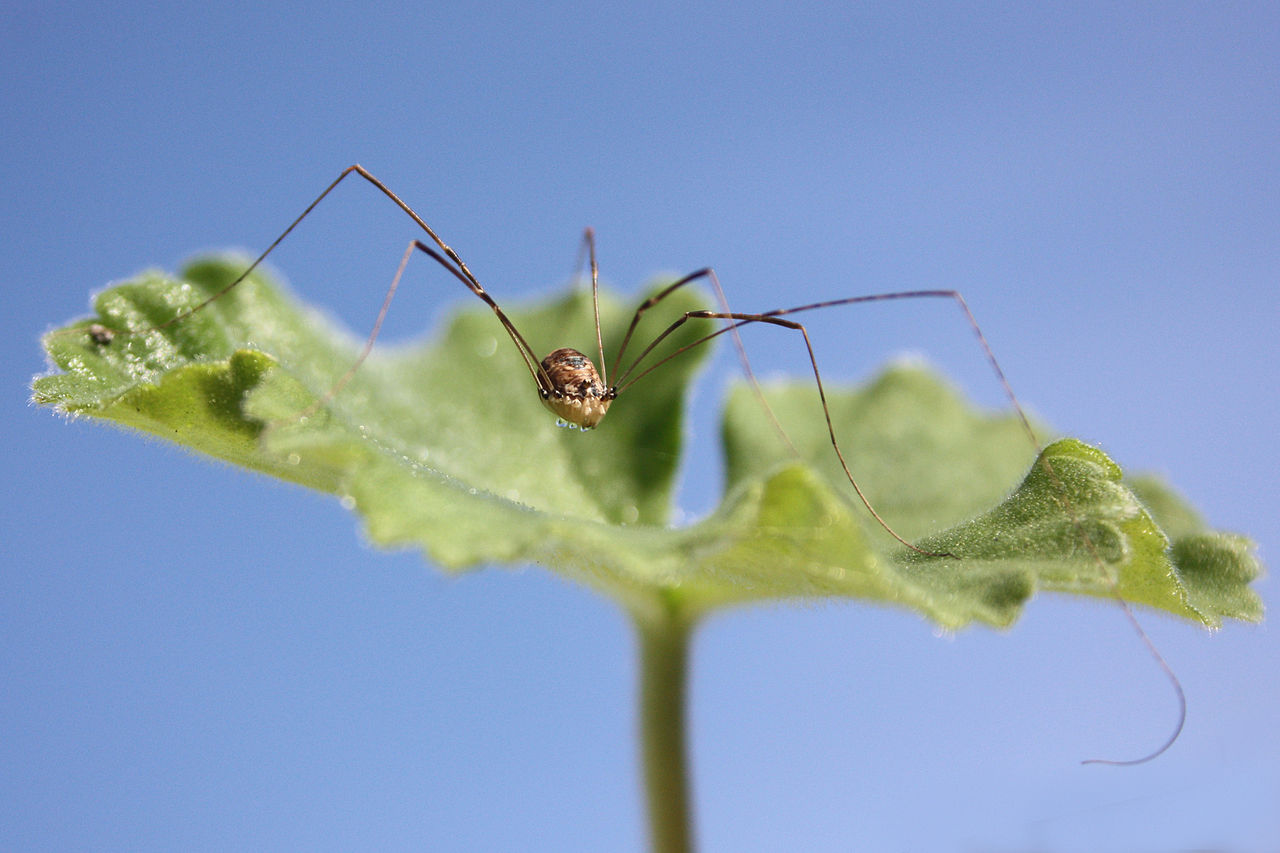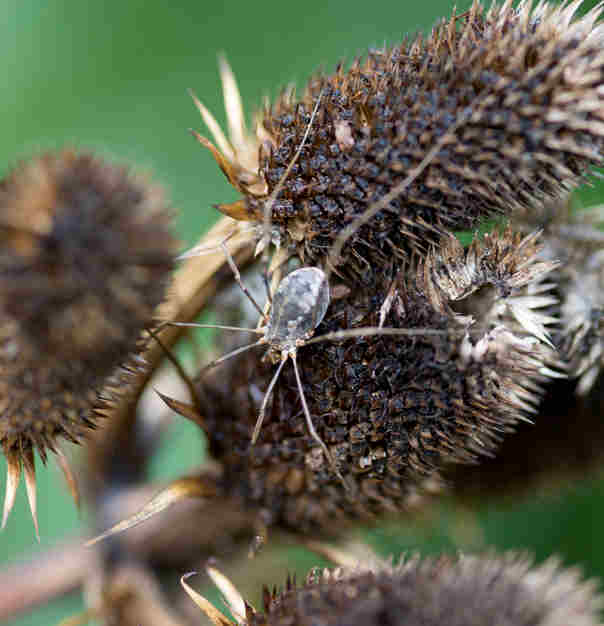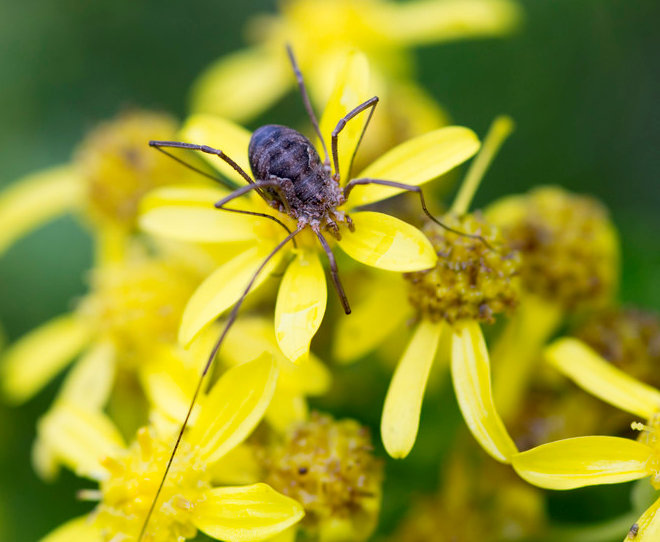- Home
- Garden Wildlife
- Arthropods
- Arachnids
- Harvestmen
Harvestmen
Harvestmen are archnids in the order Opiliones which is a very ancient group dating back at least 400 million years. They have four pairs of usually very long spindly legs and somewhat resemble long-legged spiders. Harvestmen however appear to have only a rather globular single-fused body element, while true spiders have bodies where the abdomen is visibly distinct from the fused head-and-thorax. When seen head on, the legs and body often form an M shape, with the body being situated at the bottom of the central dip. Harvestmen have small feeding structures that can tackle some solid food (unlike spiders), but they have no venom glands and are absolutely harmless to people. They have a single pair of eyes on the top of their "head". The are most likely to be seen in late summer - the original time of harvest.
Harvestmen are often called "daddy long-legs", which while memorable, should be avoided because the term is also used for craneflies, common in gardens. Harvestmen are sufficiently obscure that they generally don't have common English names for the species, but they are quite common and very fascinating.
Species in Britain and Ireland
Britain and Ireland has 26 species of harvestmen, from a global total of over 6,500 species. Jennifer Owen encountered 11 speciesfrom two families in her garden, with Odiellus spinosus the most common. Other widespread species likely to be found in gardens include Leiobunum rotundatum and Leiobunum blackwalli in the family Leiobunidae Phalangium opilio, Mitopus morio, Opilio saxatilis, Oligolophus tridens, Paroligolophus agrestis and Platybunus triangularis in the Phalangidae. Nemastoma bimaculatum is in a third family Nemastomatidae.
Another phalangid species Dicranopalpus ramosus originated in Morocco, but arrived in Britain in 1957 and has spread north to Scotland.
Two unidentified harvestmen photographed on the Plants for Bugs experimental beds at Wisley.
Biology
Harvestmen lack the venomous fangs that spiders use to subdue their prey. Harvestmen will catch and eat some small invertebrates but they also feed as scavengers on dead invertebrates, excrement and overripe fruits. Some species, such as Anelasmocephalus cambridgei, prey on snails. Harvestmen mostly live at ground level but some species, such as Leiobunum rotundatum and Paroligolophus agrestis will climb walls and trees.
Harvestmen are mainly nocturnal and during the day often rest in shaded places. When disturbed they will run away or remain stationary and bounce their bodies rapidly up and down. Resting harvestman are often encountered aggregated together, sometimes in large numbers. This short Youtube video here shows a small aggregation, and if you look carefully you can see body bouncing.
Life cycle
After mating, females deposit eggs in the soil or under loose bark. The eggs hatch into small versions of the adult animals. The developing harvestmen shed their outer skin on several occasions as they increase in size. Many species become adult in late summer, which coincides with harvest time and this is thought to be the derivation of their common name.
Role of harvestmen in gardens
Harvestmen are part of a healthy garden ecosystem. They cause no damage to plants, but are not especially useful in terms of preying on potential garden pests. As a group they are relatively unstudied, and studying them in your garden could contribute really interesting new information.
Further information
Websites
Opiliones section of the British Arachnological Society wbsite http://wiki.britishspiders.org.uk/
Short Youtube video of harvestman aggregation
Harvestmen of Britain and Ireland Field Studies Council Identikit
Natural History Museum checklist of harvestmen of the British Isles
Book
Hillyard, P. D. (2005) Synopses of the British Fauna, vol. 4, Harvestmen. Linnean Society
Page text drafted by Andrew Halstead, reviewed by Andrew Salisbury, compiled by Steve Head
.jpg)

.jpg)
.jpg)
Harvestman Odiellus spinosus Harvestman Leiobunum blackwalli showing "M" shaped stance

Left: harvestman Phalangium opilio Right: harvestman Paroligolophus agrestis showimg the single pair of eyes of harvestmen, and the tactile pedipalps.
Below, the rapidly colonising new harvestman Dicranopalpus ramosus which is easily recognised by the habit of resting with its extremely long legs stretched to the sides, and also its large bifid pedipalps.


Left: Harvestman Odiellus spinosus Right: Harvestman Leiobunum blackwalli showing "M" shaped stance
.jpg)

Harvestmen
Harvestmen are archnids in the order Opiliones which is a very ancient group dating back at least 400 million years. They have four pairs of usually very long spindly legs and somewhat resemble long-legged spiders. Harvestmen however appear to have only a rather globular single-fused body element, while true spiders have bodies where the abdomen is visibly distinct from the fused head-and-thorax. When seen head on, the legs and body often form an M shape, with the body being situated at the bottom of the central dip. Harvestmen have small feeding structures that can tackle some solid food (unlike spiders), but they have no venom glands and are absolutely harmless to people. They have a single pair of eyes on the top of their "head". The are most likely to be seen in late summer - the original time of harvest.
Harvestmen are often called "daddy long-legs", which while memorable, should be avoided because the term is also used for craneflies, common in gardens. Harvestmen are sufficiently obscure that they generally don't have common English names for the species, but they are quite common and very fascinating.
Species in Britain and Ireland
Britain and Ireland has 26 species of harvestmen, from a global total of over 6,500 species. Jennifer Owen encountered 11 speciesfrom two families in her garden, with Odiellus spinosus the most common. Other widespread species likely to be found in gardens include Leiobunum rotundatum and Leiobunum blackwalli in the family Leiobunidae Phalangium opilio, Mitopus morio, Opilio saxatilis, Oligolophus tridens, Paroligolophus agrestis and Platybunus triangularis in the Phalangidae. Nemastoma bimaculatum is in a third family Nemastomatidae.
Another phalangid species Dicranopalpus ramosus originated in Morocco, but arrived in Britain in 1957 and has spread north to Scotland.
.jpg)
.jpg)
Left: harvestman Phalangium opilio Right: harvestman Paroligolophus agrestis showimg the single pair of eyes of harvestmen, and the tactile pedipalps.
Below, the rapidly colonising new harvestman Dicranopalpus ramosus which is easily recognised by the habit of resting with its extremely long legs stretched to the sides, and also its large bifid pedipalps.

Biology
Harvestmen lack the venomous fangs that spiders use to subdue their prey. Harvestmen will catch and eat some small invertebrates but they also feed as scavengers on dead invertebrates, excrement and overripe fruits. Some species, such as Anelasmocephalus cambridgei, prey on snails. Harvestmen mostly live at ground level but some species, such as Leiobunum rotundatum and Paroligolophus agrestis will climb walls and trees.
Harvestmen are mainly nocturnal and during the day often rest in shaded places. When disturbed they will run away or remain stationary and bounce their bodies rapidly up and down. Resting harvestman are often encountered aggregated together, sometimes in large numbers. This short Youtube video here shows a small aggregation, and if you look carefully you can see body bouncing.
Life cycle
After mating, females deposit eggs in the soil or under loose bark. The eggs hatch into small versions of the adult animals. The developing harvestmen shed their outer skin on several occasions as they increase in size. Many species become adult in late summer, which coincides with harvest time and this is thought to be the derivation of their common name.
Role of harvestmen in gardens
Harvestmen are part of a healthy garden ecosystem. They cause no damage to plants, but are not especially useful in terms of preying on potential garden pests. As a group they are relatively unstudied, and studying them in your garden could contribute really interesting new information.
Further information
Websites
Opiliones section of the British Arachnological Society wbsite http://wiki.britishspiders.org.uk/
Harvestmen of Britain and Ireland Field Studies Council Identikit
Book
Hillyard, P. D. (2005) Synopses of the British Fauna, vol. 4, Harvestmen. Linnean Society
Page text drafted by Andrew Halstead, reviewed by Andrew Salisbury, compiled by Steve Head














